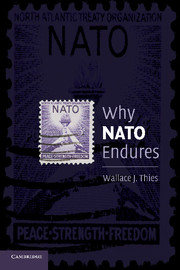Book contents
5 - NATO and the Military Balance
Published online by Cambridge University Press: 05 June 2012
Summary
I suggested in Chapter 1, that a crisis within an alliance can be thought of as a turning point – specifically, a stage in the life cycle of an alliance during which cooperation becomes noticeably more difficult because one or more members is thinking of leaving, thereby antagonizing the others and compelling them to consider their options should the alliance come apart. Put differently, an alliance is in crisis when one or more members is indifferent between (1) making an effort to repair whatever rifts have developed within it and (2) leaving the alliance in search of alternative security arrangements. As one or more members cross the crisis threshold, the others too must face the choice between staying and leaving. The longer this goes on, the greater the risk of a self-fulfilling prophecy, as each member aims to get out first rather than last.
This approach raises three sets of questions that are the subject of Chapters 5, 6, and 7. First, has the crisis threshold as defined previously ever been breached within the Atlantic Alliance? The NATO-in-crisis literature considers the Alliance to be in crisis whenever officials in various NATO capitals disagree on an important issue, become angry with each other, and so on. But this is a thoroughly unsatisfactory approach, the reason being that it is hardly surprising that NATO members might disagree – heatedly, even – concerning military strategy and tactics and that these disagreements then spill into the open.
- Type
- Chapter
- Information
- Why NATO Endures , pp. 140 - 201Publisher: Cambridge University PressPrint publication year: 2009



